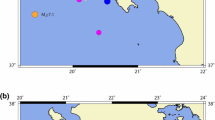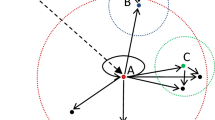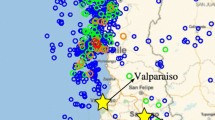Abstract
Based on the theory of complex networks, we quantify for the first time correlations between seismic events occurring in the Hellenic arc and Trench system, which is the most seismogenic structure in the European–Mediterranean region. We examine how relatively strong events with their aftershock sequences trigger phase transitions of the underlying network topology of seismic activity from random to scale-free structures. In particular, we show that the network is characterized by a highly clustered spatial structure giving rise to heterogeneous networks exhibiting enhanced small-world attributes.








Similar content being viewed by others
References
Abe S, Suzuki N (2004) Scale-free network of earthquakes. Europhys Lett 65(4):581–586
Abe S, Suzuki N (2007) Dynamical evolution of clustering in complex network of earthquakes. Eur Phys J B 59:93–97
Albert R, Barabasi AL (2002) Statistical mechanics of complex networks. Rev Mod Phys 74:47–97
Baesi M (2006) Scaling and precursor motifs in earthquake networks. Physica A 360:534–542
Baiesi M, Paczuski M (2004) Scale-free networks of earthquakes and aftershocks. Phys Rev E 69:066106. doi:10.1103/PhysRevE.69.066106
Baiesi M, Paczuski M (2005) Complex networks of earthquakes and aftershocks. Nonlinear Proc Geophys 12:1–11
Barrat A, Barthelemy M, Vespignani A (2008) Dynamical processes on complex networks. Cambridge University Press, UK, p 368
Costa L d F, Rodrigues FA, Travieso G, Villas Boas PR (2007) Characterization of complex networks: a survey of measurements. Adv Phys 56:167–242
Fagiolo G (2007) Clustering in complex directed networks. Phys Rev E 76:026107. doi:10.1103/PhysRevE.76.026107
Frohlich C, Davis SD (1993) Teleseismic b-values; or, much ado about 1.0. J Geophys Res 98:631–644
Gutenberg B, Richter CF (1944) Frequency of earthquakes in California. Bull Seismol Soc Am 34:185–188
Hirata T (1989) Fractal dimension of fault systems in Japan: fractal structure in rock fracture geometry at various scales. Pure App Geophys 131:157–170
Ishimoto M, Iida K (1939) Observations of earthquakes registered with the microseismograph constructed recently. Bull Earthq Res Inst 17:443–478
Jiang C, Wu Z (2012) Testing the forecast of aftershocks: a simple method with an example of application. Res Geophys 2(e5):29–33. doi:10.4081/rg.2012.e5
Jones LM, Molnar P (1979) Some characteristics of foreshocks and their possible relationship to earthquake prediction and premonitory slip on fault. J Geophys Res 84:3596–3608
Kreemer C, Chamot-Rooke N (2004) Contemporary kinematics of the southern Aegean and the Mediterranean Ridge. Geophys J Int 157:1377–1392
Krishna Mohan TR, Revathi PG (2011) Earthquake correlation and networks: a comparative study. Phys Rev E 83:046109. doi:10.1103/ PhysRevE.83.046109
Le Pichon X, Angelier J (1979) The Hellenic arc and Trench system: a key to the evolution of eastern Mediterranean. Tectonophysics 60:1–42
Lomnitz C (1974) Global tectonics and earthquake risk. Developments in Geotectonics 5. Elsevier, Amsterdam, p 320
Lotfi N, Darooneh AH (2012) The earthquakes network: the role of cell size. Eur Phys J B 85:23. doi:10.1140/epjb/e2011-20623-x
McClusky S, Balassania S, Barka A et al (2000) GPS constraints on plate motions and deformation in the Eastern Mediterranean: implications for plate dynamics. J Geophys Res 105:5695–5719
McKenzie DP (1970) Plate tectonics of the Mediterranean region. Nature 226:239–243
McKenzie DP (1972) Active tectonics of the Mediterranean region. Geophys J Roy Astr S 30:109–185
Mogi K (1962) Study of elastic shocks caused by the fracture of heterogeneous materials and its relation to earthquake phenomena. Bull Earthq Res Inst 40:125–173
Musson RMW, Tsapanos TM, Nakas CT (2002) A power-law function for earthquake inter-arrival time and magnitude. Bull Seismol Soc Am 92:1783–1794
Newman MEJ (2003) The structure and function of networks. Siam Rev 45:167–256
Ogata Y (1998) Space–time point-process models for earthquake occurrences. Ann Inst Stat Math 50:379–402
Olami Z, Feder HJS, Kim Christensen K (1992) Self-organized criticality in a continuous, nonconservative cellular automaton modeling earthquakes. Phys Rev Lett 68:1244–1247
Omori F (1894) On the aftershocks of earthquakes. J Coll Sci Imp Univ Tokyo 7:111–200
Papadopoulos GA (1993) On some problems about testing stochastic models of the earthquake time series. Nat Hazards 7:99–108
Papadopoulos GA (2011) A seismic history of Crete–Hellenic Arc and Trench, 2000 BC–2011 AD. Ocelotos, Greece, p 414
Papadopoulos GA, Charalampakis M, Fokaefs A, Minadakis G (2010) Strong foreshock signal preceding the L’Aquila (Italy) earthquake (Mw 6.3) of 6 April 2009. Nat Hazards Earth Sy S 10:19–24
Papazachos BC (1990) Seismicity of the Aegean and the surrounding area. Tectonophysics 178:287–308
Reilinger R, McClusky S, Vernant P et al. (2006) GPS constraints on continental deformation in the Africa–Arabia–Eurasia continental collision zone and implications for the dynamics of plate interactions. J Geophys Res 111:(B5). doi:10.1029/2005JB004051
Stam CJ, Reijneveld JC (2007) Graph theoretical analysis of complex networks in the brain. Nonlinear Biomed Phys 1(3):1–19. doi:10.1186/1753-4631-1-3
Tsapanos TM (1990) b-Values of two tectonic parts in the circum-pacific belt. Pure Appl Geophys 134(2):229–242
Turcotte DL (1997) Fractals and chaos in geology and geophysics. Cambridge University Press, Cambridge, p 416
Utsu T (1962) On the nature of three Alaskan aftershock sequences of 1957 and 1958. Bull Seismol Soc Am 52:279–297
Utsu T (2002a) A list of deadly earthquakes in the world: 1500–2000. In: Lee WHK, Kanamori H, Jennings PC, Kisslinger C (eds) International handbook of earthquake & engineering seismology part A. Academic, San Diego, pp 691–717
Utsu T (2002b) Statistical features of seismicity. In: Lee WHK, Kanamori H, Jennings PC, Kisslinger C (eds) International handbook of earthquake & engineering seismology part A. Academic, San Diego, pp 719–732
Utsu T (2002c) Relationship between magnitude scales. In: Lee WHK, Kanamori H, Jennings PC, Kisslinger C (eds) International handbook of earthquake & engineering seismology part A. Academic, San Diego, pp 733–746
Watts DJ, Strogatz SH (1998) Collective dynamics of “small-world” networks. Nature 393:440–442
Yamashita T (1998) Simulation of seismicity due to fluid migration in a fault zone. Geophys J Int 132:674–686
Zhuang J (2012) Long-term earthquake forecasts based on the epidemic-type aftershock sequence (ETAS) model for short-term clustering. Res Geophys 2(e8):52–57. doi:10.4081/rg.2012.e8
Author information
Authors and Affiliations
Corresponding author
Appendix
Appendix
Usually, the statistical properties of networks are studied in terms of the following basic quantitative measures (Watts and Strogatz 1998; Albert and Barabasi 2002; Newman 2003):
-
(a)
The average path length (APL). It is defined as the mean value of all the shortest paths between any two nodes, reading:
where d i→j is the shortest path between i and j nodes and N is the size of the network. The average path length is a global property of a network indicating the average number of steps needed to reach any two nodes.
-
(b)
The global efficiency. In the case where a network is disconnected that is at least two nodes do not communicate, the APL is infinity. In order to overtake this problem, the global efficiency E is defined as
If two nodes are disconnected, then \( \frac{1}{d_{i\to j}}=0 \), i.e. the efficiency is zero. The inverse of global efficiency 1/E is the harmonic mean of the shortest paths, and it is similar to APL.
-
(c)
The clustering coefficient c i . The clustering coefficient c i of the node i is the number E i of linked triangles it forms with its neighbours, divided by the number of all possible triangles that i node forms. In the case of directed networks, the c i takes the form (Fagiolo 2007):
where A is the adjacency matrix of the network, k tot is the summation of inward and outward degrees, i.e. k tot = k in + k out and the parenthesis (⋅) ii indicate the main diagonal of the ⋅ matrix. The ACC of the whole network is defined as the mean value of the clustering coefficients c i .
-
(d)
The degree distribution P(k) which gives the fraction of nodes with exactly k edges connected to it. Characteristic examples of almost symmetric-around the mean value of the degree distributions are the Erdős–Rényi networks (Albert and Barabasi 2002; Barrat et al. 2008; Newman 2003); scale-free networks are characterized from power-law distributions with exponent γ (Barrat et al. 2008; Newman 2003). In the case of directed network, the degree distribution is replaced by the distribution of inward or outward degrees.
-
(e)
The entropy of the degree distribution is defined as
which provides a measure for the heterogeneity of the network. Higher values of H indicate the existence of heterogeneous degree distribution (Costa et. al 2007): There are few nodes acting as hubs (i.e. having big degree). Examples of such distributions are the power laws (or scale-free) with heavy tails in their degree distribution.
Rights and permissions
About this article
Cite this article
Daskalaki, E., Papadopoulos, G.A., Spiliotis, K. et al. Analysing the topology of seismicity in the Hellenic arc using complex networks. J Seismol 18, 37–46 (2014). https://doi.org/10.1007/s10950-013-9398-8
Received:
Accepted:
Published:
Issue Date:
DOI: https://doi.org/10.1007/s10950-013-9398-8




